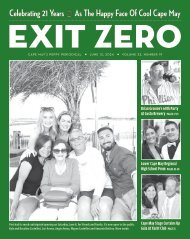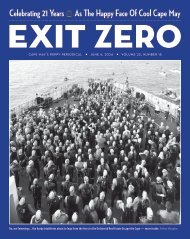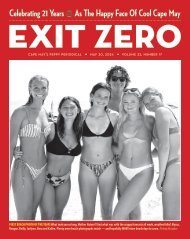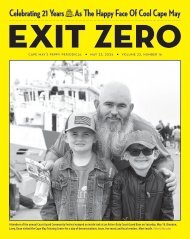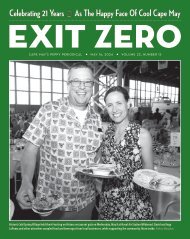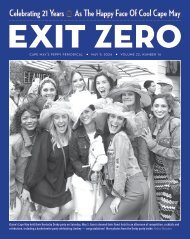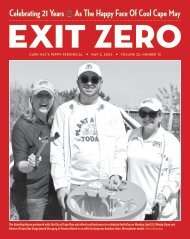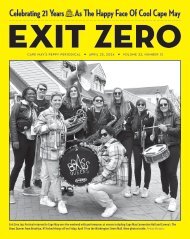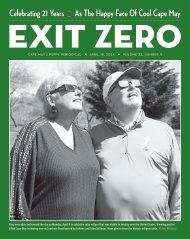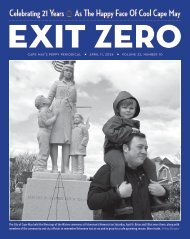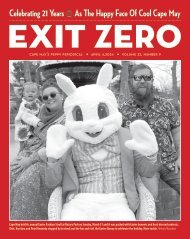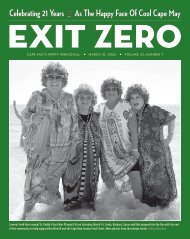Cool Cape May 2021-22
You also want an ePaper? Increase the reach of your titles
YUMPU automatically turns print PDFs into web optimized ePapers that Google loves.
[46] excerpt from the cape<br />
The original<br />
manuscript,<br />
which remains<br />
at the offices<br />
of Exit Zero<br />
Publishing in<br />
<strong>Cape</strong> <strong>May</strong><br />
New Yorker, and Rick Moody, an acclaimed novelist<br />
best known for The Ice Storm.<br />
I was mortified and wrote another note to<br />
George, apologizing for what must have come across<br />
as a very patronizing email — here I was explaining<br />
the basics of the publishing industry to someone who<br />
seemed steeped in it. But he hadn’t been offended in<br />
the least and was surprised I could even find him on<br />
Google. (George is as humble as he is charming.)<br />
Later that year, George returned to our offices to<br />
tell us more about his grandfather. Charles Whitecar<br />
Miskelly, for all his obvious skills with words, was no<br />
professional writer. He was born in 1880 and grew up<br />
in Millville, NJ. He became a carpenter, although he<br />
later gave that up to start breeding chickens. According<br />
to George, the enterprise didn’t work out as<br />
Charles had hoped and sometime in the 1930s his<br />
grandfather lost everything. “He didn’t have a cent to<br />
his name,” said George, “so he went back into carpentry<br />
and did what he could to feed his family.”<br />
George grew up in nearby Bridgeton and<br />
although he had more than a passing interest in writing,<br />
he didn’t discuss literature with his grandfather.<br />
“We would go on fishing trips — he loved to fish on<br />
the Maurice River. But he would never discuss writing.<br />
I was always aware that he wrote a lot, on a typewriter<br />
held together with fishing wire, but that was<br />
the extent of it.” On a typewriter held together with<br />
fishing wire. You can see how easy it was to fall in love<br />
with the story of this book.<br />
It was only after his grandfather passed away,<br />
in 1963 at the age of 83, that George discovered the<br />
manuscript and learned about the trip that Charles<br />
had made, with his uncle, to the Philadelphia office of<br />
J. B. Lippincott. “My grandfather was a shy man and<br />
he got cold feet about visiting the publisher, but my<br />
uncle apparently talked him into it,” said George. “I<br />
don’t know what happened in that office, but Lippincott<br />
were keen on putting the book on their fall print<br />
list. However, it all fell apart when they told Charles<br />
they wanted to make some changes.”<br />
George kept the manuscript, along with other<br />
stories written by his grandfather, in a closet for a<br />
long time — more than 40 years. It was only when<br />
he retired, in 2008, that he decided to devote time to<br />
finally finding a publisher.<br />
I feel proud, if I can be proud on behalf of a man<br />
who I never met, to present this compelling piece<br />
of work to the world. My guess is that you will be as<br />
astonished as I was by the detailed descriptions of the<br />
Lenni-Lenape way of life. This was a writer who had<br />
either done a huge amount of research into Native<br />
American culture, or who had substantial personal<br />
experience of it. Given that Charles wrote this book<br />
in rural South Jersey (about 60 years before Google<br />
came along) and wasn’t given to taking day trips to<br />
visit the Free Library of Philadelphia, it made me<br />
wonder how he could have had access to this kind of<br />
information. It made George wonder, too. “It’s a big<br />
mystery to everyone in the family how he would have<br />
known so much about the indian way of life,” he said.<br />
“Sure, he would maybe go away fishing for the day, or<br />
walking in the woods. But that doesn’t explain how he<br />
could have learned so much about the Lenni-Lenape<br />
people.”<br />
Does George think the author’s note is genuine<br />
— that the book is based on a true story passed along<br />
by tribal elders? Or could Charles have played a little<br />
fast and loose, trying to pass his manuscript off as an<br />
authentic story rooted in Lenni-Lenape tradition.<br />
“No, not at all,” said George. “He was a serious man,<br />
a man of principles. The whole thing is fascinating. I<br />
wish he were around to ask.”<br />
So do I.<br />
By the way, I looked up the company who made<br />
the paper on which Charles typed his story — the<br />
American Writing Paper Corporation began operations<br />
in 1899 at Holyoke, MA, and at its peak controlled<br />
75% of the country’s fine paper output. The<br />
company went out of business in 1962. On the side<br />
of the box is a little blue stamp that says Cohanzick<br />
Office Supply Co., who were based in Bridgeton,<br />
which neighbors Charles’ home town of Millville. I<br />
don’t know who owned the office supply shop, but<br />
was curious to see that Bridgeton’s zoo (the oldest<br />
in New Jersey) is named Cohanzick. After a little bit<br />
of keyboard research, I discovered that the zoo was<br />
named for the Cohanzick tribe of Lenni-Lenape indians<br />
who at one time lived alongside the Cohansey<br />
River in Bridgeton.<br />
It made me wonder — did Charles Whitecar<br />
Miskelly buy the box of typewriter paper from an<br />
office supply company owned by a Lenni-Lenape<br />
family? Did he have connections to the tribe that even<br />
his own family didn’t know about? Printer deadlines<br />
prevented me from digging any deeper, but if there’s<br />
a reprint (a boy can dream), maybe I will be able to<br />
discover more about the story behind the story.<br />
And now, that’s more than enough musing from<br />
me... go ahead and read the story of John McJack.<br />
Here’s chapter one...




